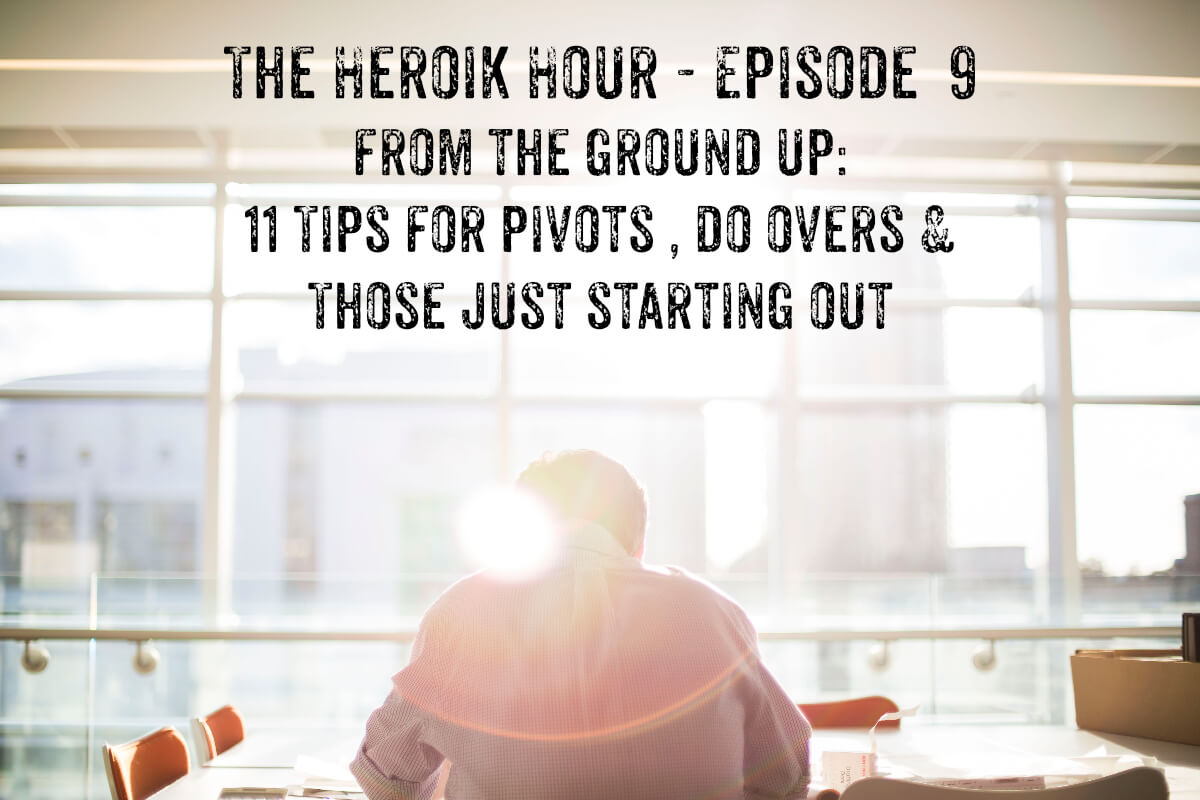Disclaimer: Below is the script I use and riff from for the show. It doesn’t have everything, and if you’re looking for the hidden track after party and the tips and nuggets therein, you’ll have to listen to the entire end of the show.
The Heroik Hour – Episode 09 – 11 Tips for Do Overs, Pivots & Starting From the Ground Up
Welcome to the Heroik Hour, the podcast where we discuss and bring together Technology Leadership and Culture giving you a little Heroik TLC to get your growth engine rev’d up and mission ready for life. I’m your host, Nicholas McGill , Chief Experience Officer for Heroik Media. Thanks for joining us on episode 9. I’m so grateful you’re listening in to my humble podcast.
I recently had my 31st birthday and I took some time to reflect on my journey, and the business moves I’ve made; the good the bad and ugly. And I thought what would I want to pass on to someone who was thinking about starting something new or different, or changing course with their practice or lives. And so on this episode, I’ll be sharing 11 tips, 11 things I’d do, if I were starting from the ground up or looking to pivot and transform my company.
Before we get into it – I love sharing all these wonderful elements of growth strategy both personally and professionally, and I work with a very special team to do this, to elevate, connect, and grow, people businesses and ideas. This is what Heroik Media is all about, we build and implement growth strategies from thought to profit. And we love every minute of it. So if you like what you hear and you need some advice, or you need to hire a team to help you with your business check us out at getheroik.com. There you’ll find some epic content, and insights, and links to our corporate site where you can learn more about how you can grab a cup of clarity for a one on one, have me speak, brainstorm and train your team, and so much more. Be sure to check it out at getheroik.com Alright. Thank you so much for letting me share that with you, and without further adieu, let’s start the show.
So in the 15+ years I’ve been on this crazy Heroik journey, what take aways come to mind, thinking of those looking to turn around their businesses, teams, or lives? Let’s start with the goal.
- Aim Big. Who do you want to work with? At what level?
Meandering with the answer and taking anything that comes is adventurous, but foolish as well. I’ve made this mistake and had to restart far too many times because of it. Everyone is not your customer or your target or your ideal client. DREAM BIGGER.
Who do you want to work with? If you struggle to answer this, take the time right now, find a piece of paper, draw a line down the middle so you have two columns side by side. Start by mapping out who you don’t want to work with on one column, I bet you can’t think of many ideas here. You may need to get a second pen or pencil for this exercise. Then when you’ve got 10-20 items down, move on to the other column, and define the opposite or better condition for each item you placed in the first.
Pack your BAGS. What’s Your Big Audacious Goal Statement? I used to think I’d never know the answer to this, but I did, I was just afraid to admit what my preference was, because I knew it would take a lot of work. AIM FOR THE STARS. I don’t care if you’re 14 or 55, AIM BIG!
If there were 5 rungs on a ladder that could connect where you are now to your ultimate goal, Each rung representing 5 stages of your path to achieving that goal, what would they be? Map that out. Define 5 stages. Break down your journey, and focus on one rung at a time. Climb that ladder.
THINK BIGGER. AIM HIGHER. IF YOU AIM FOR THE FLOOR, THE BEST CASE SCENARIO IS YOU’LL HIT IT. If you plan to settle for less, then less is what you’ll design and position for, and you may receive even less than you were planning. So think bigger, aim bigger, design bigger and and you’ll get more. It is that simple. Aiming for anything by its nature will allow you to get closer than not having a target at all. Don’t learn this the hard way.
- Start with an adaptive brand, a brand that can become anything relevant to your specialty area. One of the few things I’m proud of is creating a mothership brand early on. Think like a media company or production studio or a superhero. You will create many movies, shows, products, etc. You can create and test sub brands, or become a startup factory, or think tank or consultancy, but what is the brand that excites you and charges your battery? For me I loved the idea of being Heroik because I wake up everyday and ask more of myself than the day before, it’s advancing, growth minded, positive and good. What’s your idea? What’s your Heroik identity? Let that help you define a brand and a flag you’d sail under for a decade or so. It’s as much for you as it is your customers.
Substance matters. So many people try to build platforms without any original content. Then they complain when they recognize that they’re a commodity.
The message is often more important than the vehicle. If all you’re doing in your practice is regurgitating the headlines and hard work of others, you don’t have a message, and you’re the vehicle.
The vehicles that deliver the message change so quickly that they’re commoditized. The message and content, if it’s good, will carry on and continue to be carried as the mediums change. If you like someone else’s content great, but rather than share it, tear it apart. Be discerning look to see it’s imperfections, look to see how you’d do it differently. Form a hypothesis and put it to the test in the market. This is how you build substance.
- Focus on Product. People buy products all day everyday, even if they don’t use them. When it comes to services, they hesitate and think about it, and take longer to convert. Services give people pause. People buy all sorts of junk but the idea of services provided by other human beings brings greater scrutiny.
You could call a service a product and sell it as such and it often outperforms the service provider doing the same thing. Services are often vague or broad, products, which are often well packaged services are more focused and deliver specific benefits.
Services provided by people require a lot of active work, day in day out. As a service provider, you constantly have to pour your tea, that is spend resources of time, energy and attention into keeping the services relevant.
Even office work in the service sector is like the manual labor of our day and is commoditized as such. Be wary of trading your time for money for too long.
It’s fine in the beginning, as you master a new discipline, build relationships, but be mindfully looking for ways to create products that help people along the way. This will help you create things that allow you to scale yourself professionally, and augment the value of your time.
There are so many ways to create information products these days. They don’t have to be huge, mind blowing or revolutionary. They can be small, tiny, and helpful. Focus on the helpful stuff, the stuff that really solves a problem.
- Have a platform in mind from the start. It’s okay if it’s a raft or a life boat. Start with a product. Then create 3. Let your time, your 1 on 1, be the ultimate prize and an expensive and valuable experience. If you want to escape the drudgery of jumping from one gig to the next in a frantic craze, you need to focus on scaling yourself by building a platform. Have a brand, have a product. Have a site. Take the time to create amazing content and great experiences on that site.
- Let your goals shape the brand, let your experience refine it, and continue to tell the story of you are as a person, professional, and organization as you figure it out. People look at big organizations and their brands and mistakenly believe that they’ve got their shit together. Sure they make money, create things and have all sorts of people working for them, but having worked with some of the biggest and best organizations out there, I assure you, they are amazingly dysfunctional, messy, full of shit, and surprisingly chaotic behind the scenes. Don’t let the numbers fool you.
They are oh so very human, and no where near perfect. I take this insight for granted but if you’re cramping your neck as you look up to the goliaths and skyscrapers, don’t be so intimidated.
When you’re small and starting out, or starting over, you have several legs up on the biggest and best of them. You can position yourself as a brand on a journey of growth, a brand that’s figuring things out, looking forward, a brand that is an explorer, a brand that is Heroik.
And you can tell the story as it unfolds and all it’s misadventures, and twists and turns, because unlike the mighty brands you’ve set realistic expectations and invited the world to join you, and offered to be transparent and sharing with your audience.
This is vastly underrated and essential and it takes years to turn around the big players to bring this degree of alignment and authenticity in their brands. In this way you can be powerful, nimble and disruptive.
Don’t work like a contractor. I don’t care if you are one. Think like a brand. Welcome clients onto your platform. It’s your raft. Have them engage on your terms. You’re the guide. It’s your boat. They’re paying you to take them somewhere. Own the experience and stay in control of what you need to.
Early on in my career, I thought I was doing my clients a favor by building their platforms for them. This is like building a boat for someone who doesn’t know how to drive it, and doesn’t know the river they’re on.
It doesn’t end well, and when things go south they blame you. They don’t take responsibility, You let them, the newbie drive it into a log or a sandbar, or crash it some other way.
It is better for both of you if you bring them aboard your vessel, show them the ropes and build together, making your platform better, getting them what they need, until they’re ready to graduate into their own.
Capture the portfolio story as you go. Get the testimonial as you go, get a testimonial when the energy is high. Require clients to submit a journal in your engagements – to manage expectations and be quotable.
- Hire, network and spend time empowering A players. And fire the under performers that add drag to your practice. Life is abundant with choices, so don’t think that everyone you run into is irreplaceable. A network of mediocre professionals you barely know is far less useful and more of a vanity metric compared to a well vetted and well groomed success team. Who are your 20 all stars? Who would you want on your board?
- Filter, Discern, Remember the Golden Rule. The Heroik Golden Rule – cultivate that which serves you and hit the eject button on that which does not. EVERYTHING is subject to evaluation through this rule including friends, family, spouses, religion, everything. You are responsible for your life. There’s too many victims on this planet, you need to be Heroik.
In the age of infinite options, choices, platforms, and channels, discernment is king. The filter, the discipline of how we filter, the apps that filter, and help us narrow down to what’s really important, become increasingly more valuable. There is so much great stuff to do, to have, to learn, and to become, but you can’t do it all, you have to make trade-offs, and you need a personal discipline, and systems to help you discern what will truly serve you, what will be great, and what’s merely mediocre.
Filter:
- Notifications
- Kill Email
- Kill the news
- Cut the cord on traditional commercial TV
- There’s so much great content out there, no reason to tolerate the mediocre forms of entertainment.
- Vampire Subscriptions
- SaaS model – Adobe Creative Suite for Example
- Be mindful with apps – Don’t spend hours of casual gaming if you want to get shit done.
Make Trade-Offs
Sports – I prefer to play them than watch from the sidelines. Maybe that will change later on, but on weekends, I’d rather be rucking with friends, and doing real things than watching hours of other people doing things and all the commercials that come with it.
- Don’t let the cost of acquiring a customer exceed or equal their lifetime transactional value. If you spend $5,000 and 6 months to acquire a customer who will only do $3,000 worth of business with you, you’ve lost not only $2,000 but also the resources associated with the hard costs of delivery as well.
Pay attention to how much you spend acquiring and serving customers and how much you make over the course of the relationship. DON’T assume you’ll be friends forever with your customers. Make sure you know how to keep the relationship going and money flowing your way, and delivering value at every step.
- HOLD ON TO LEVERAGE – This is what gives you a seat and a captivated audience at the negotiation table in the first place.
I used to believe that as an altruistic and Heroik professional that acting in good faith meant showing my hand, and how everything works. People will take the plans and run if you let them. Stop giving the plan away for free, or at the very least, leave critical keys out just in case.
Leverage comes in many forms; unique knowledge and insight, power, audience, control of the platform, ownership of assets, etc. Giving away all your leverage thinking with a mentality, of healing the world one altruistic action and huge leap of faith at a time is a strategy that completely dependent on the mood and morals of other party doing the right thing with the information.
I care about doing what is right and good and true, and I bought into the bad practice, that if I share it, build, or give it away, the partnerships and relationships will come back 10 fold. This doesn’t happen in business, with business assets.
This rule – is only a true rule of character, meaning – give kindness generously because it bares returns, as does sincerity, authenticity, and humility every now and again.
But giving away leveragable assets of the deal, hoping to build a good relationship, results in false relationships with people who will only keep you around as long as they continue to receive value at the low price of free.
And even if you wise up, to cut off the free train, you’re likely to settle for low amounts, as you have very little leverage built into your model. These aren’t the clients you want.
And I don’t want you to get robbed or become bitter or cynical before you learn to be mindful and responsible for the experiences and exchanges you create and influence. Be kind, frame value, speak candidly, but do not show your hand until the check has cleared.
- Get the little things right. Do less but better. Stop worshipping high volumes and start caring about the level of conversions and engagement levels. Overbuilding mediocre crap at rapid pace isn’t likely to bring you the type of clients you want and doing that will train you to cater to the only customers you can attract, the crappy ones. This in turn will send you down a journey of encouraging you to create more crappy products for customers you don’t resonate with – the world doesn’t need another Kmart version of whatever you’re doing.
- For the love of God, just swing already. Get Failures out of the way, as fast as possible. This means building and shipping products instead of services. It took me years to just sit down and hammer out a book, not from a lack of content, but just from a fear of failure. Don’t be afraid. Failure is part of the game. Pay attention with each at bat, and if you fail to make a hit, have some take-aways some ideas as to what went wrong. Spend some time doing the post mortem review, and see what you need to change. I think the biggest misnomer with failure is that it’s permanent. I struggle thinking about some of my personal failures but I can’t go back and change them. I can make damn sure I’m better next time. My biggest tip here, is to find a place, build an environment with an accountability group, where you can pitch in front of them, and if you’re gonna fail, it may as well be a small failure, in front of trusted friends who want to see you succeed. Take a practice round.
- There is no silver bullet. Like so many people and teams, I spent hours, weeks, months and years chasing easy buttons before I arrived at a big truth. There aren’t any. There’s a lot of talk about them but at the end of the day, there’s just hard work that needs to be done. Learn to climb the pile – become a workload warrior, don’t run from it and stop perfecting the art of procrastination. There are no silver bullets. There are incremental, iterative improvements.
That’s all the time we have today. Thank you so much for tuning in to this episode of the Heroik Hour, now it’s time to get your energy up, move around a bit, to get heroik, go for that victory lap, and feel alive – I’ll catch you next time – let’s crank it.





0 Comments